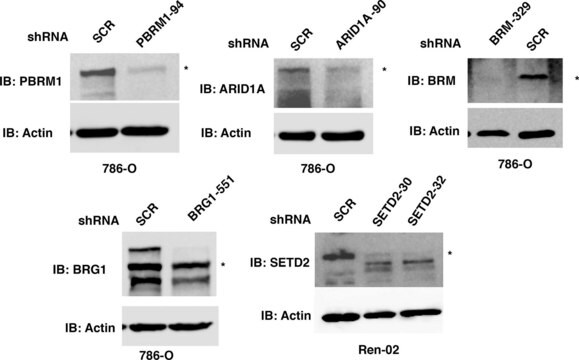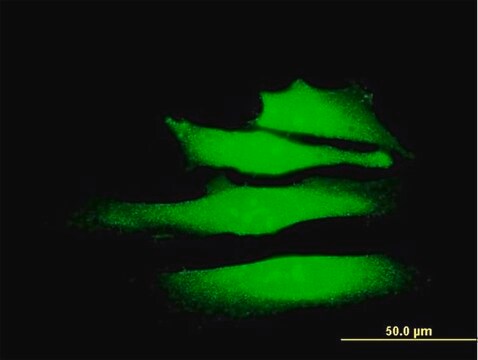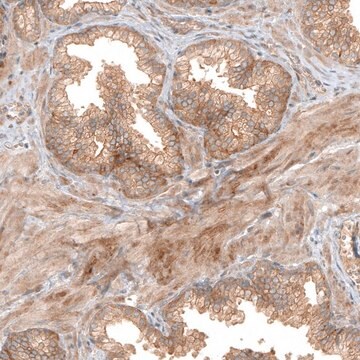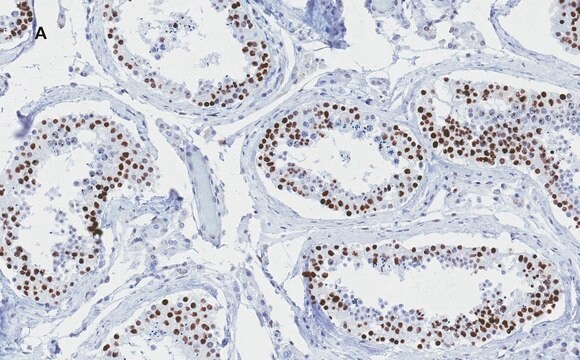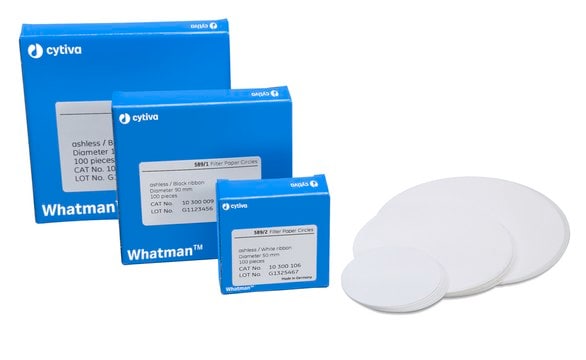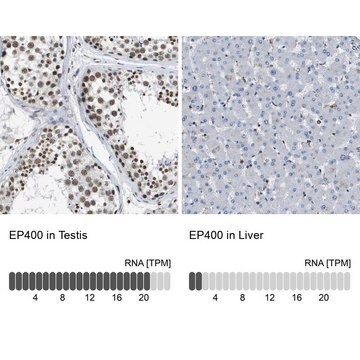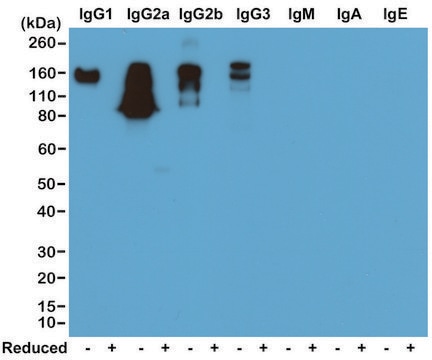MABE89
Anti-Brm Antibody, clone 1H7A10
clone 1H7A10, from rat
同義詞:
SWI/SNF related, matrix associated, actin dependent regulator of chromatin, subfamily a, member 2, ATP-dependent helicase SMARCA2, probable global transcription activator SNF2L2, sucrose nonfermenting 2-like protein 2, SNF2/SWI2-like protein 2, SWI/SNF-r
登入查看組織和合約定價
全部照片(1)
About This Item
分類程式碼代碼:
12352203
eCl@ss:
32160702
NACRES:
NA.41
推薦產品
生物源
rat
品質等級
抗體表格
purified antibody
抗體產品種類
primary antibodies
無性繁殖
1H7A10, monoclonal
物種活性
mouse
技術
immunohistochemistry: suitable
western blot: suitable
同型
IgG2aκ
NCBI登錄號
UniProt登錄號
運輸包裝
wet ice
目標翻譯後修改
unmodified
基因資訊
human ... SMARCA2(6595)
一般說明
BAF190B (BRG1-associated factor 190B), also known as protein brahma homolog (Brm), and SNF2-alpha, functions as a transcriptional coactivator. This protein contains a helicase domain and is a member of the SWI/SNF family of proteins and is part of the SWI-SNF chromatin remodeling complex. The SWI-SNF complex is involved in the activation of transcription via the remodeling of nucleosome structure in an ATP-dependent manner. This large complex contains multiple proteins. BAF190 (Brm) and Brg-1 (SNF2-beta) are the ATPase subunits of the mammalian SWI-SNF complex. Brm, Brg-1, Ini1 (integrase interactor 1, or SNF5), BAF155 (SRG3) and BAF170 are thought to comprise the functional core of the SWI-SNF complex. Other complex subunits are thought to play regulatory roles. hSNF2L and hSNF2H both appear to be homologs of Drosophila ISWI, a Brm related ATPase that is present in chromatin remodeling complexes other than SWI/SNF, including the NURF (nucleosome remodeling factor).
特異性
Recognizes BAF190B also known as Brm
免疫原
Recombinant protein corresponding to amino acids 48-214 of mouse Brm.
應用
Immunocytochemistry:
A representative lot of this antibody was reported to work in IC using C2C12 cells (Yasuyuki Ohkawa, SSP Stem Cell Unit, Faculty of Medicine, Kyushu University, Fukuoka, Japan.)
Immunohistochemistry:
A representative lot of this antibody was reported to work in IHC using mouse embryonic and postnatal brain (Yasuyuki Ohkawa, SSP Stem Cell Unit, Faculty of Medicine, Kyushu University, Fukuoka, Japan.)
A representative lot of this antibody was reported to work in IC using C2C12 cells (Yasuyuki Ohkawa, SSP Stem Cell Unit, Faculty of Medicine, Kyushu University, Fukuoka, Japan.)
Immunohistochemistry:
A representative lot of this antibody was reported to work in IHC using mouse embryonic and postnatal brain (Yasuyuki Ohkawa, SSP Stem Cell Unit, Faculty of Medicine, Kyushu University, Fukuoka, Japan.)
Research Category
Epigenetics & Nuclear Function
Epigenetics & Nuclear Function
Research Sub Category
Chromatin Biology
Chromatin Biology
Use Anti-Brm Antibody, clone 1H7A10 (Rat Monoclonal Antibody) validated in WB, IHC to detect Brm also known as ATP-dependent helicase SMARCA2 or SNF2/SWI2-like protein 2.
品質
Evaluated by Western Blot in K562 nuclear extract.
Western Blot Analysis: 0.5 µg/mL of this antibody detected Brm on 10 µg of K562 nuclear extract.
Western Blot Analysis: 0.5 µg/mL of this antibody detected Brm on 10 µg of K562 nuclear extract.
標靶描述
~140-180 kDa observed. Uncharacterized lower molecular weight bands have been reported in some lysates and may represent splice variants and/or degradation products. See Batsché E, Yaniv M, Muchardt C. Nat Struct Mol Biol. 2006 Jan;13(1):22-29.
外觀
Protein G
Format: Purified
Purified rat monoclonal IgG2aκ in buffer containing 0.1 M Tris-Glycine (pH 7.4), 150 mM NaCl with 0.05% sodium azide.
儲存和穩定性
Stable for 1 year at 2-8°C from date of receipt.
分析報告
Control
K562 nuclear extract
K562 nuclear extract
其他說明
Concentration: Please refer to the Certificate of Analysis for the lot-specific concentration.
免責聲明
Unless otherwise stated in our catalog or other company documentation accompanying the product(s), our products are intended for research use only and are not to be used for any other purpose, which includes but is not limited to, unauthorized commercial uses, in vitro diagnostic uses, ex vivo or in vivo therapeutic uses or any type of consumption or application to humans or animals.
未找到適合的產品?
試用我們的產品選擇工具.
儲存類別代碼
12 - Non Combustible Liquids
水污染物質分類(WGK)
WGK 1
閃點(°F)
Not applicable
閃點(°C)
Not applicable
分析證明 (COA)
輸入產品批次/批號來搜索 分析證明 (COA)。在產品’s標籤上找到批次和批號,寫有 ‘Lot’或‘Batch’.。
Xiang Liu et al.
Molecular medicine reports, 14(6), 5435-5442 (2016-11-15)
Isoflurane is a commonly used inhaled anesthetic, which induces apoptosis of SH‑SY5Y cells in a dose‑ and time‑dependent manner; however, the underlying mechanisms remain unknown. The authors of the present study hypothesized that a mutation in β‑amyloid precursor protein (APP)
我們的科學家團隊在所有研究領域都有豐富的經驗,包括生命科學、材料科學、化學合成、色譜、分析等.
聯絡技術服務